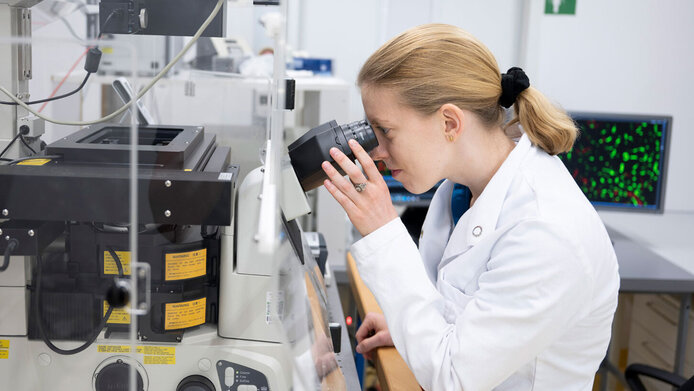How we age and what helps us along with that

If you are an attentive reader of research reports or even tabloids, you will have read about the substances resveratrol (contained in red wine) and catechins (in green tea). Depending on the quality level of the publication, they are variously described as playing a positive role in ageing processes or as a fountain of youth. Corina Madreiter-Sokolowski, an assistant professor at the Medical University of Graz, has been very dispassionate in her exploration of the potential of the two substances as senolytics or senomorphics. Senolytics are therapeutic agents that induce ageing cells to die, while senomorphics help cells to be better prepared for ageing processes.
In addition to a cellular ageing model, Madreiter-Sokolowski used the nematode Caenorhabditis elegans as a model organism, since it shares most of the functional proteins and signalling cascades with humans, especially with regard to ageing processes. Its lifespan is nothing like 80 years, however, but only 30 days, which considerably accelerates the testing of active ingredients. As a Schrödinger fellow with funding from the Austrian Science Fund FWF, Madreiter-Sokolowski specifically explored the role of mitochondria as signallers in the ageing process at ETH Zurich. After returning from Switzerland, she set up a nematode laboratory at the Medical University of Graz, where she harnesses the established resources of fluorescence microscopy and develops them further via the nematodes.
Model organisms in ageing research
Mitochondria are popularly called the powerhouse of the cell, because they generate the universal energy source ATP (adenosine triphosphate). They do however change their activity depending on the age of the cell and the calcium supply, as Corina Madreiter-Sokolowski notes: “On the one hand, mitochondria provide the energy to keep cells vibrant with the help of calcium; on the other hand, they also bring about cell death when the calcium content increases as part of cell ageing.” During her doctoral studies in Graz, Madreiter-Sokolowski developed a cell culture model that allows her to study the calcium balance and the processes involved in the mitochondria in more detail. In her post-doc period at ETH Zurich she added the model organism Caenorhabditis elegans to her set of methods. Apart from its comparatively rapid ageing process, the nematode offers the advantage of being transparent, which enables the researcher to observe the processes in the one-millimetre-long worm and the labelled proteins it contains under a microscope.
Calcium balance in the cellular powerhouse
In cooperation with the Medical University of Graz, Madreiter-Sokolowski was able to prove that in the course of ageing mitochondria move closer to the endoplasmic reticulum (ER), another cell organelle, and interact more strongly. The ER folds proteins for use in the cell, but is also the largest intracellular calcium store. Calcium acts as a signalling substance to encourage metabolism in the cellular powerhouse so that enough of the energy-supplying ATP is produced. For ageing cells the proximity between ER and mitochondria can also become a threat, as Madreiter-Sokolowski explains: “Resveratrol, an ingredient of red wine, increases the calcium uptake of the mitochondria, which drives the old cells to cell death.” Thus it acts as a senolytic which targets ageing cells when they absorb even more calcium and kills them off.
And why is it important for old cells to die? They damage their environment through inflammatory processes and release a larger amount of oxygen radicals. Ageing better with red wine sounds like a pleasant way to spend one's retirement. But Madreiter-Sokolowski is still reticent about advising it. “Drinking a lot of red wine is more likely to give you cirrhosis of the liver than a longer life,” she says jokingly. However, she also confirms that researchers are working at full steam to bring substances with a similar mechanism of action into use in humans.
Regulation of oxygen radicals
And what about green tea as a fountain of youth? At ETH Zurich, Madreiter-Sokolowski was able to explore the full potential of oxygen radicals in this context. Radicals have a bad reputation because they attack DNA, RNA, proteins and lipids. On the other hand, they are regularly produced in the mitochondria as part of ATP production and, in small doses, are essential signalling molecules: “When we briefly increase the level of oxygen radicals by changing the mitochondrial processes in the worm using ingredients from green tea, the whole organism is trained to defend itself against them, comparable to a vaccination. Proteins that break down radicals are thus boosted promptly when needed.” In the tests, middle-aged nematodes that were administered green tea catechins proved indeed to be fitter in old age than untreated nematodes.
It is still too early to make dosage recommendations, however. For the active-ingredient studies on the worms, the team had to gradually grope their way to the right dose. In addition, the plant compounds under study have low bioavailability, which means that little of the active ingredient actually reaches the target site. Based on her research results, Madreiter-Sokolowski has now set up her own research group at the Medical University of Graz. The team is looking for new substances that can activate the described life-prolonging mechanisms in an even better way. But at least the research results have now been able to provide first confirmation of what has been widely discussed and publicised in the form of popular food supplements holding out the promise of a long life.
Personal details
Corina Madreiter-Sokolowski studied Pharmacy at the University of Graz and conducted her postdoctoral research with a Schrödinger Fellowship from the Austrian Science Fund FWF at Michael Ristow’s lab at the Department of Health Sciences and Technology at ETH Zurich and with Wolfgang Graier at the Gottfried Schatz Research Centre at the Medical University of Graz. In December 2020, she was appointed assistant professor of molecular biology and biochemistry at the Medical University of Graz. In May 2022, the Austrian Academy of Sciences honoured the achievements of Madreiter-Sokolowski with the Elisabeth Lutz Award, its most highly endowed prize for young researchers.
Publications
Tawfik I., Gottschalk B., Jarc A., Bresilla D. et al.: T3-induced enhancement of mitochondrial Ca2+ uptake as a boost for mitochondrial metabolism, in: Free Radical Biology and Medicine Vol. 181, 2022
Madreiter-Sokolowski CT, Gottschalk B., Sokolowski AA, Malli R., Graier W.F.: Dynamic Control of Mitochondrial Ca2+ Levels as a Survival Strategy of Cancer Cells in: Frontiers in Cell and Developmental Biology, 2021
Tian J., Geiss C., Zarse K., Madreiter-Sokolowski CT, Ristow M.: Green tea catechins EGCG and ECG enhance the fitness and lifespan of Caenorhabditis elegans by complex I inhibition, in: Aging, Vol. 13, 2021





